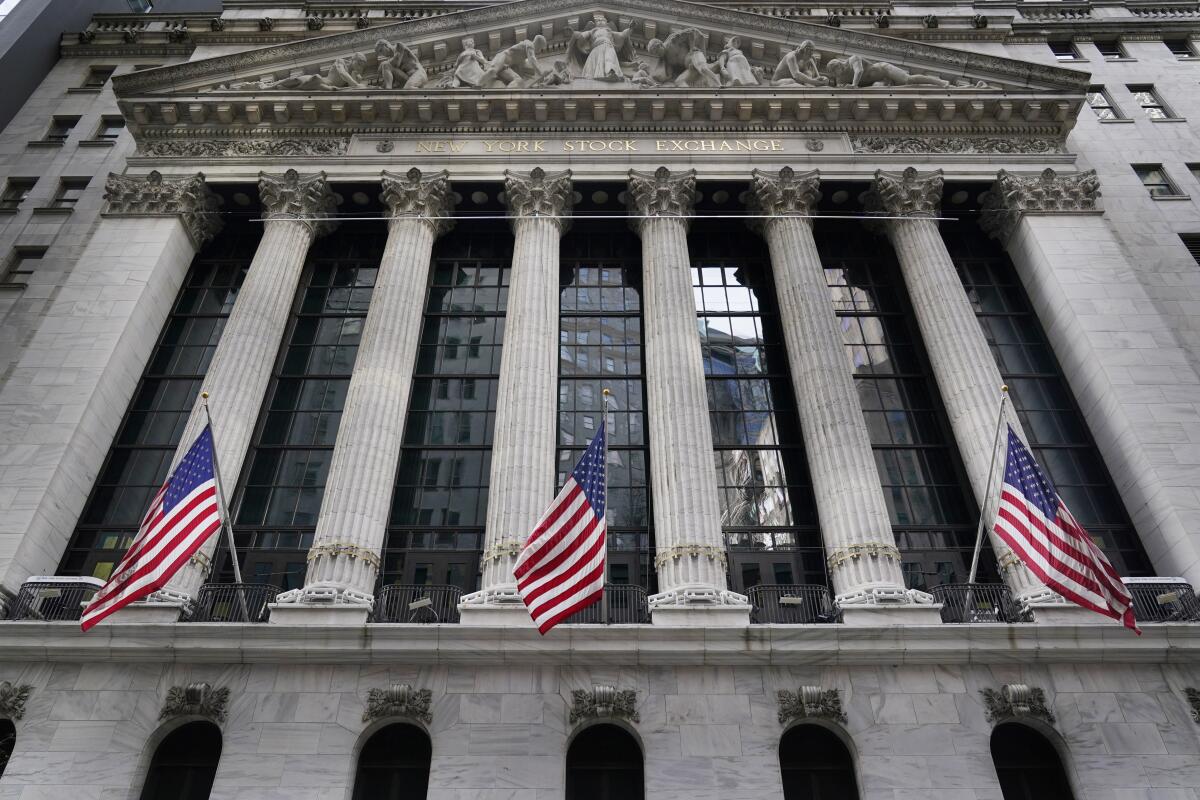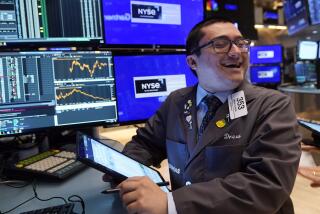A 10% drop for stocks is scary, but it’s not that rare

- Share via
The worries rocking Wall Street about interest rates, inflation and now Ukraine have sent the Standard & Poor’s 500 index — the most widely followed measure of the U.S. stock market — tumbling more than 10% from its record.
It’s a big enough fall that Wall Street has a name for it: a correction. Such drops occur regularly, and market pros tend to see them as potentially healthy setbacks that can clear out unjustified market exuberance or excessive risk-taking.
But they’re frightening in the moment, particularly for every new generation of investors that gets into the market at a time when it seems like stocks only go up. The S&P 500 more than doubled between late March 2020 and early January, when it set its last all-time high.
Stocks closed broadly lower Tuesday after Russia sent forces into Ukraine’s eastern region and the U.S., European Union and U.K. responded with economic sanctions.
Taking a little froth out of the market is one thing. The larger fear, which always accompanies a correction, is that a correction could augur a bear market, which is what Wall Street defines as a stock-index drop of at least 20%.
Here’s a look at what history shows about past corrections and what market watchers are expecting going forward.
What’s behind the correction?
Much of this drop is the result of fears about an abrupt shift to higher interest rates. After years of keeping interest rates super low, the Federal Reserve is set to start raising short-term rates to help corral the high inflation that’s blazing across the global economy.
Higher rates can keep a lid on prices by slowing the economy, but they can cause a recession if they get too high. They also often serve to suck money out of riskier areas of the market, including stocks. When interest rates are higher and safe investments such as bonds are paying more in interest, investors are less willing to pay high prices for more speculative plays.
The Fed has been buying trillions of dollars’ worth of bonds through the pandemic to keep longer-term rates low, an action Wall Street terms “printing money.” Investors expect the Fed to throw this process into reverse, which would act much like additional rate increases.
More recently, worries about tensions with Russia over Ukraine have accelerated the market’s tumble. Beyond the human toll, a conflict in the region could send prices for oil and other energy commodities soaring and further stoke inflation.
How often do corrections occur?
Every couple of years, on average. Even during the historic, nearly 11-year-long bull run for U.S. stocks from March 2009 to February 2020, the S&P 500 suffered five corrections, according to CFRA. Worries about factors such as interest rates, trade wars and a European debt crisis caused the pullbacks.
In 2020, a correction did graduate to a bear market after the global economy suddenly shut down because of the pandemic. That sent the S&P 500 on a breathtaking drop of nearly 34% in about a month.
This is the 24th time in the last 50 years that the S&P 500 has fallen at least 10%, including both bear markets and milder corrections.
How quickly do they usually happen?
Not quite this fast. Looking only at corrections since World War II that didn’t end up becoming bear markets, it took an average of 76 days for the S&P 500 to lose 10% from a recent high, according to CFRA. This time, it took 50 days.
Of course, things could be worse. In February 2020, the S&P 500 tumbled more than 10% from a record in just over a week. That ended up being the start of the quickest bear market on record, as well as the shortest.
What usually happens after a drop like this?
Looking only at corrections since 1946 that managed to right themselves before turning into a bear market, the S&P 500 has taken an average of 135 days to hit bottom and lost an average of 14% along the way, according to CFRA. The index has taken an average of 116 days to recoup its losses.
For declines that become bear markets, the damage is much worse. Going back to 1929, the average bear market has taken an average of nearly 20 months to hit bottom and caused a loss of roughly 39% for the S&P 500, according to S&P Dow Jones Indices.
How bad can a bear market be?
On paper, investors can lose most of their money. From late 1929 to mid-1932, the stock market fell a little more than 86%, for example.
A bear market can also feel interminable: One lasted more than five years, from 1937 into 1942, when U.S. stocks lost 60%, according to S&P Dow Jones Indices.
In Japan, the Nikkei 225 index is still trying to get back to the peak it set at the end of 1989. It remains roughly 30% below that level.
The Japanese example is an outlier, though. In almost every case, investors would have made back all their losses from a bear market for U.S. stocks if they simply held on and didn’t sell. That includes the 2000 dot-com bust, the 2008 financial crisis and the 2020 coronavirus collapse.
Have rising-rate worries caused other corrections?
If the Fed does raise short-term rates next month, which investors see as a certainty, it would be the first such increase since 2018.
At that time, the S&P 500 sank nearly 20% amid worries the Fed was being too aggressive in raising rates and shrinking its balance sheet. The index avoided a full-blown bear market only after the Fed shifted and said that it would be “patient” in its policies. It didn’t raise rates again.
Should we expect the same thing to happen again
No one knows. Some investors on Wall Street say they expect the Fed to again loosen up before the stock market falls too sharply. But the Fed is facing much higher inflation this time around than in late 2018 and early 2019. The consumer price index leaped 7.5% in January from a year earlier, its hottest rate in four decades.
More to Read
Inside the business of entertainment
The Wide Shot brings you news, analysis and insights on everything from streaming wars to production — and what it all means for the future.
You may occasionally receive promotional content from the Los Angeles Times.











